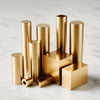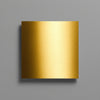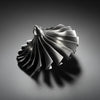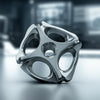How Laser Cutters Operates in Prototyping & Low-Volume Manufacturing

The Laser Cutting Advantage for Prototypes & Small Batches
In product development, speed and precision are non-negotiable. Laser cutting delivers both:
-
24-hour turnaround for complex 2D/3D parts
-
±0.1mm tolerance without tooling investment
-
Material flexibility – from 0.5mm acrylic to 20mm steel
-
Zero setup costs vs. stamping/punching
For engineers managing NPI or bridge production, mastering laser operation is critical.
Laser Cutting: A Photon-Powered Process
Step 1: Beam Generation
-
CO₂ Lasers (10.6μm wavelength): Ideal for plastics, wood, fabrics. Excited CO₂ gas emits photons amplified through mirrors.
-
Fiber Lasers (1.06μm wavelength): Perfect for metals, ceramics. Solid-state diodes pump light into fiber-optic cables.
Prototyping Tip: CO₂ lasers cut acrylic with polished edges; fiber lasers oxidize steel less.
Step 2: Beam Delivery & Focusing
-
Optics Path: Mirrors direct beam through a collimator (parallel alignment) into a focusing lens (e.g., 2.5" focal length).
-
Spot Size: A 0.1mm diameter beam achieves power densities up to 10⁷ W/cm² – hotter than the sun’s surface.
Step 3: Material Interaction
-
Vaporization (Plastics): Photons break molecular bonds (e.g., acrylic sublimates at 350°C).
-
Melt-Ejection (Metals): Molten material blown away by assist gas (N₂ for oxidation-free cuts; O₂ for faster steel cutting).
Precision Control Systems
| Component | Function | Prototyping Impact |
|---|---|---|
| Motion System | Linear guides + servo motors | Positional accuracy: ±5μm |
| Nozzle | Delivers assist gas (0.5–20 bar pressure) | Clean cuts in 1mm stainless steel |
| PWM Controller | Modulates beam power (1–100 kHz) | Prevents acrylic melting in thin walls |
| Z-Axis Auto-Focus | Maintains focal point (±0.05mm) | Consistent kerf width across warped sheets |
Overcoming Prototyping Challenges
1. Material-Specific Kerf Control
-
Kerf Width: Typically 0.1–0.4mm (varies by material/thickness).
-
Compensation: CAD offset = (Kerf Width)/2 to hit dimensions.
-
Data Point: Cutting 3mm aluminum with N₂ assist: 0.15mm kerf.
2. Heat-Affected Zone (HAZ) Minimization
-
Pulsed Cutting: Microsecond bursts reduce thermal spread (critical for electronics enclosures).
-
Cooling Strategies: Chill plates (-10°C) for heat-sensitive alloys.
3. Nesting Efficiency
-
AI nesting software (e.g., SigmaNEST) boosts material yield to 85%+ vs. manual layout (avg. 70%).
-
Case Study: 304 stainless steel prototype batch: 22% cost reduction via optimized nesting.
Laser vs. Alternative Prototyping Methods
| Method | Lead Time | Min. Batch | Tolerance | Setup Cost |
|---|---|---|---|---|
| Laser Cutting | <24 hours | 1 piece | ±0.1mm | $0 |
| CNC Punching | 3–5 days | 50+ pieces | ±0.2mm | $1,500+ |
| Waterjet | 2–4 days | 1 piece | ±0.25mm | $300 |
Note: Lasers outperform waterjets in speed (5× faster for 3mm acrylic) and edge quality.
Future Innovations: Prototyping Applications
-
Hybrid Additive Manufacturing:
-
Laser-cut substrates + 3D-printed features (e.g., electrical contacts on polymer housings).
-
-
AI-Powered Defect Detection:
-
Real-time thermal imaging identifies micro-cracks during cutting.
-
-
Ultrafast Picosecond Lasers:
-
"Cold cutting" of medical device polymers with <1μm HAZ.
-
Best Practices for Prototype Engineers
-
Design for Laser Cutting (DfLC):
-
Minimum hole diameter = 1.2× material thickness
-
Avoid sharp corners – use 0.3mm radii to prevent burning.
-
-
Material Selection Guide:
Material Max Thickness Edge Quality Acrylic 25mm Optical polish Stainless Steel 20mm Oxidation-free PCB Laminate 3mm No delamination -
Post-Processing:
-
Acrylic: Flame polishing for optical clarity.
-
Steel: Passivation to restore corrosion resistance.
-
Conclusion: Laser Cutting—The Prototyper’s Scalpel
From concept validation to pre-production batches, laser cutting eliminates traditional manufacturing constraints. Its digital workflow (CAD → CAM → Cut) enables:
✅ Same-day design iterations
✅ Per-part costs 60% lower than CNC for flat geometries
✅ Zero tooling investment
For prototypes and runs under 500 units, it remains the fastest path from sketch to functional part.
Ready to Laser-Cut Your Prototype?
XTJ has ISO 9001 certified & 16949 certified laser cutters with 48-hour turnaround.
Upload your CAD file for a free quotation!
-
Posted in
cnc machining, laser cutting, precision machining, rapid prototyping, sheet metal fabrication





